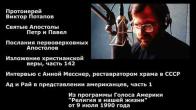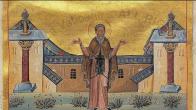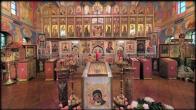You are here
The Origin and Meaning of the Paschal Greeting
In accordance with the rite established by the Church, we exchange a Paschal kiss during Matins on the first day of Holy Pascha. The rite is both important and comforting.
Ordinarily, when we exchange that kiss, we say, “Christ is Risen!” and are answered with the words “Truly He is Risen!” In so doing, we emulate the earliest of the Lord’s disciples and students, who after His Resurrection discussed the Resurrection among themselves, and said: the Lord is Risen indeed (Luke 24: 14-35). Moreover, in pronouncing that greeting, we clearly and concisely express to one another the history of today’s Feast.
On the other hand, the greeting fills our soul with inexpressible joy. When you say, or hear someone say, the sweet words “Christ is Risen!” “Truly He is Risen!” you feel particularly happy. Thus, one might say that another reason for [those words of greeting] to have come into general practice is that they produce joy in the soul. They produce joy because they contain that sweet hope in our own coming resurrection. The Apostle Paul states, “But now is Christ risen from the dead, and become the first fruits of them that slept...” (I Corinthians 15: 20). It follows that, if Jesus Christ was resurrected, we shall be as well. This is something of great comfort to all of us, especially to those whose path in this life is sown with weeds and tares. Indeed, it is terrible to live a life of want, and then become a victim of death for all eternity. But to live in want here, and then to finally move into a blessed eternity, and together with your resurrected body to enjoy blessed happiness.... Can anything be more longed for than this? That is the reason both for our pleasure in hearing the words “Christ is Risen!” “Truly He is Risen!” and for their general usage in our greetings to one another.
Moreover, in greeting one another in this way, we also exchange a kiss. What is the meaning of that kiss? In ordinary life, a kiss is considered a sign of sincere mutual love. It has the same meaning in this Paschal rite. As St. John Chrysostom said, “The Feast of Pascha is a pledge of peace, a fountain of reconciliation, the destruction of death, the devil's ruin. Today people have become one with the angels…”
Thus, on such a glorious Feast day, can we Christians continue to bear enmity for anyone? Is it even possible not to possess sincere love for one another? “Let us be radiant for the Feast,” the Holy Church sings to us, “and let us embrace one another. Let us say, Brethren, even to them that hate us, let us forgive all things on the Resurrection!” It is in that spirit that our kiss should be exchanged. Otherwise, it resembles Judas’ kiss.
Finally, after pronouncing those most-sweet words, “Christ is Risen!” – “Truly He is Risen!” and exchanging the kiss, we give one another red eggs. The Egg is a sign of our blessed resurrection from the dead, whose pledge we have in Jesus Christ. So that you might understand how the egg is a token of our resurrection, imagine what happens to it after the chicken has incubated it for a few days: from out of it, a new creature emerges, a creature whose life had been hidden within its dead shell. In precisely like manner, the Giver of Life rose from the tomb, death’s abode; the time will come when, through the power of Almighty God, and in response to the Archangel’s sounding trumpet, our bodies will come out of the heart of the earth and will be clothed with incorruption. It is of this that the eggs we give one another remind us.
Do you know the origin of this custom? It is quite an ancient one. According to tradition, it began with the Equal to the Apostles St. Mary Magdalene. After the Lord’s Ascension, she came to Rome to preach the Gospel. Standing before Emperor Tiberias and saying, “Christ is Risen!” she presented him with a red egg. In those days, it was customary for poor people to give their friends, benefactors, the wealthy, and authorities, an egg on the New Year and on birthdays, as a sign of respect. Following Mary Magdalene’s example, early Christians began giving eggs to one another on the days celebrating Christ’s Glorious Resurrection. They passed that custom on to us.
But why did it become the custom to give one another red eggs? According to tradition, the following took place: On the actual day of Christ’s Resurrection, when everyone was convinced that Jesus Christ could not possibly rise from the tomb, a certain Jew was carrying a basket of eggs to market. Along the way, he met another Jew who said to him, “So, friend, do you know what a miraculous thing has happened in our city Jerusalem? For Christ, Who died three days ago, has risen from the tomb, and already many have seen Him.” However, the Jew who was taking the fresh eggs to market said to him, “No, I do not believe that Christ has been resurrected from the tomb. That would be just as impossible as to have white eggs suddenly turn red.” And what happened? As soon as he had spoken those words, the white eggs in the basket suddenly turned red. That miracle so amazed him that he rushed to adopt the Christian Faith. News of that marvelous event soon spread among the faithful Christians, and in commemoration thereof, they began to exchange red eggs with one another. It was perhaps for that reason that Mary Magdalene presented Emperor Tiberius with a red egg.
At the same time, the red color of the Paschal egg has a special significance. It would be no sin to assert that it represents the Blood of our Lord Jesus Christ. Had Jesus Christ not redeemed us, we would have remained eternal prisoners of hell and death, and consequently would not have any reason to hope in our own coming resurrection. But we have been redeemed, redeemed through the priceless Blood of our Lord. Consequently, we will certainly be resurrected. As our redemption was accomplished with the Blood of Jesus Christ, we receive our coming resurrection, acquired through that same Blood. The eggs’ red color reminds us of that, and specifically preaches to us the fact that our resurrection is the fruit or consequence of the spilling of our Savior’s priceless Blood.
April 2007
PARISH LIFE
RECENT VIDEOS
Address of our Cathedral
Subscribe to our mailing list
While all the materials on this site are copyrighted, you may use them freely as long as you treat them
with respect and provide attribution on the Russian Orthodox Cathedral of St.John the Baptist of Washington DC.









